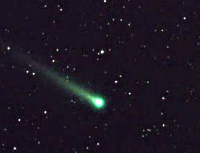
FOR THE WEEK OF DEC. 02, 2013
Ancient comet that circled the sun could create a bright sky show here

![]() Find other science or technology coverage of interest and summarize what’s cool or interesting.
Find other science or technology coverage of interest and summarize what’s cool or interesting.
![]() Identify an article or photo about something that doesn’t seem scientific, but actually involves chemistry, biology, medical science or earth science.
Identify an article or photo about something that doesn’t seem scientific, but actually involves chemistry, biology, medical science or earth science.
![]() Can you find a quote or photo from someone with a job that required training in at least one STEM (science, technology, engineering, math) subject?
Can you find a quote or photo from someone with a job that required training in at least one STEM (science, technology, engineering, math) subject?
Something special happened far above Earth on Thanksgiving, captivating astronomers. It may sound like a sci-fi movie, but is a real-life phenomenon: A comet that's over 4 billion years old spun around the sun and emerged on the other side as if propelled from a slingshot. Spacecraft from NASA and the European Space Agency watched the ancient comet, named ISON by scientists, plunge toward the sun. Its tail has been visible for a while, and some parts apparently survived last Thursday's hot close encounter. It could put on a spectacular, multi-week sky show in our Northern Hemisphere.
Comets are giant snowballs of frozen gases, rock and dust that come from the solar system's edge and can be several miles in diameter. When they get close enough to see, scientists study them for clues about how our solar system formed. "It now looks like some chunk of ISON's nucleus has indeed made it through the solar corona," Karl Battams of the Naval Research Laboratory said a day after Thanksgiving. "Now that it has emerged and started to brighten, we need to observe it for a few days to get a feel for its behavior."
"It certainly appears as if there is an object there that is emitting material," says Alan Fitzsimmons, an astronomer in Northern Ireland who specializes in comets and asteroids (more solid space rocks that have no tail). "This is what makes science interesting. If we knew what was going to happen, it wouldn't be interesting." A smaller comet named Lovejoy grazed the sun and survived in 2011, but fell apart a couple of days later.
![]() Explaining the name: Two Russian astronomers first spotted Comet ISON in September 2012 and named it after their night-sky survey program, the International Scientific Optical Network -- observatories in 10 countries that track objects in space
Explaining the name: Two Russian astronomers first spotted Comet ISON in September 2012 and named it after their night-sky survey program, the International Scientific Optical Network -- observatories in 10 countries that track objects in space
![]() Scientist says: "This has been one of the most extraordinary comets we have ever encountered, and just goes to reiterate how beautiful, dynamic and exciting our universe is." -- Karl Battams, Naval Research Lab in Washington, DC
Scientist says: "This has been one of the most extraordinary comets we have ever encountered, and just goes to reiterate how beautiful, dynamic and exciting our universe is." -- Karl Battams, Naval Research Lab in Washington, DC
![]() Professor says: "Comet ISON has the potential to be among the brightest comets of the last 50 years." -- Dennis Bodewits, astronomer at University of Maryland
Professor says: "Comet ISON has the potential to be among the brightest comets of the last 50 years." -- Dennis Bodewits, astronomer at University of Maryland
Front Page Talking Points Archive
Common Core State Standard
SL.CCS.1/2/3/4 Grades 6-12: An essay of a current news event is provided for discussion to encourage participation, but also inspire the use of evidence to support logical claims using the main ideas of the article. Students must analyze background information provided about a current event within the news, draw out the main ideas and key details, and review different opinions on the issue. Then, students should present their own claims using facts and analysis for support.
©2024 Boston Herald in Education and Online Publications Inc. and NIEonline.com
![]()
![]()





